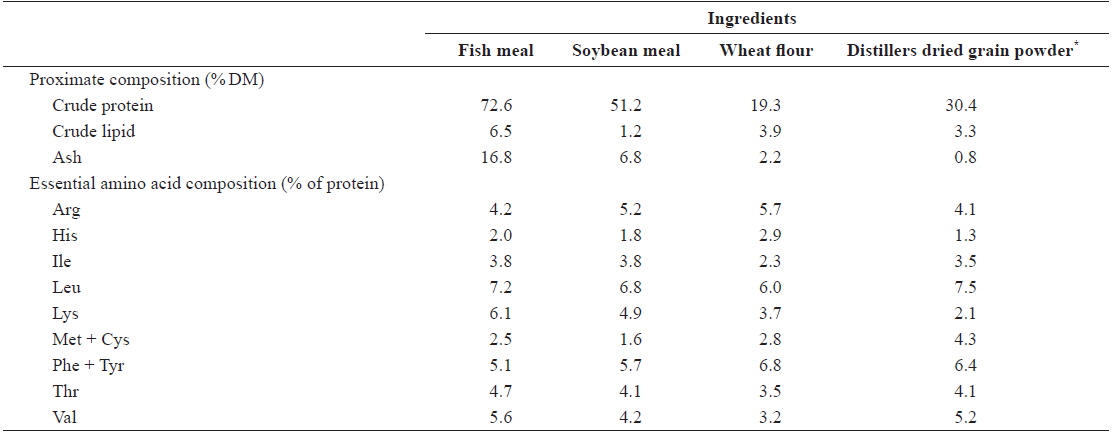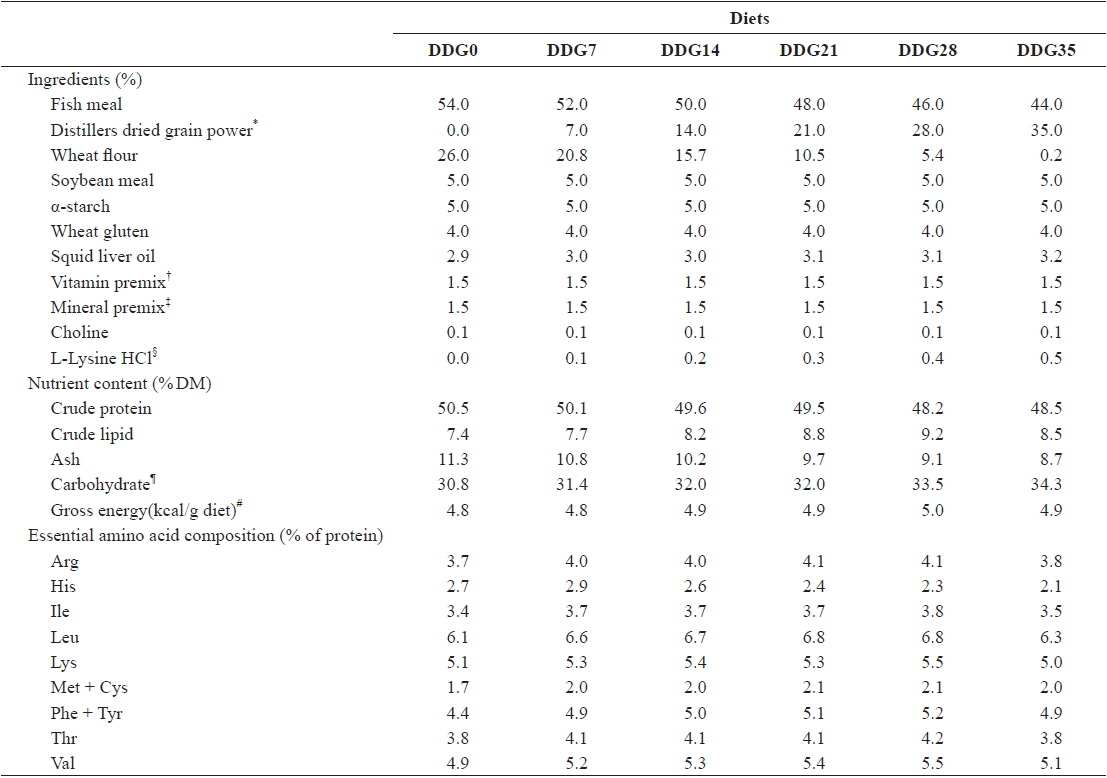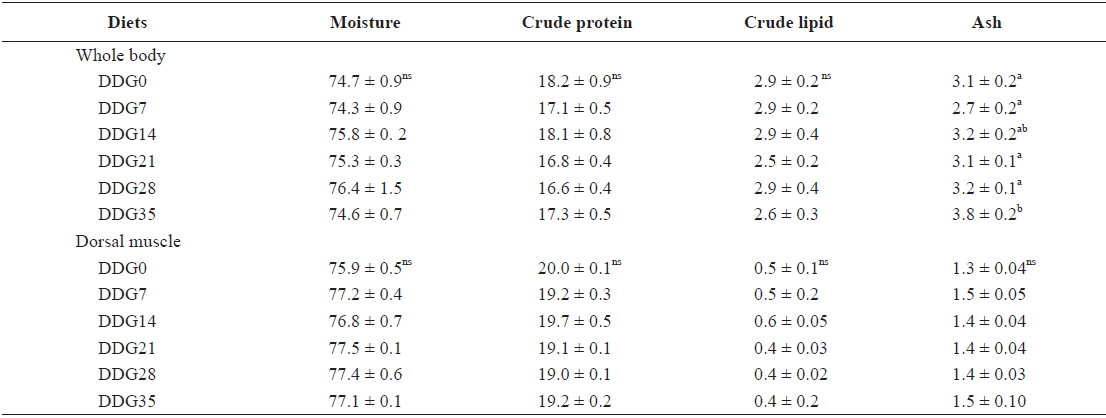



Protein is the most expensive dietary nutrient component in aquaculture feeds and significantly affects the growth performance of aquatic species. Fish meal has been used as a major protein source in fish diets because of its good quality and palatability. However, when global fish meal production declines relative to demand and fish meal costs increase, fish nutritionists begin evaluating cost-effective alternative protein sources originating from plants. Many protein sources have been investigated as potential partial replacements for fish meal in feeds for fish (Allen et al., 2000; Lee, 2002; Albrektsen et al., 2006; Santigosa et al., 2008; Dapra et al., 2009). The efficiency of alternative protein sources as partial replacements for fish meal has been evaluated for many carnivorous cultured fish (Regost et al., 1999; Robaina et al., 1999; Elangovan and Shim, 2000).
Among the protein sources available for animal feeds, cereal by-product is a good candidate for partial replacement of fish meal protein in diets (Chevanan et al., 2010). One alternative protein source is distillers dried grain (DDG), a cereal by-product of the distillation process. Corn-based DDG has been widely used as a protein source for ruminant feed (Firkins et al., 1985; Larson et al., 1993; Ham et al., 1994; Lodge et al., 1997; Ganesan et al., 2008). DDG is also considered to be a good feed ingredient for fish because it has a relatively high protein content (Zhou et al., 2010; Li et al., 2011). Research studies have been conducted on the use of corn-based DDG as a protein source in feeds for freshwater fishes such as rainbow trout
The olive flounder is one of the most important marine cultured fish species in Asia because of its advantages such as fast growth, the establishment of seedling production, and developed culture techniques. Based on our findings, we hypothesized that rice DDG in the olive flounder diet might improve growth and reduce feed costs. Therefore, the objectives of present feeding trial were to evaluate the effects of dietary rice DDG as a partial replacement for fish meal in the practical diet on growth performance, feed utilization, and body composition of juvenile olive flounder.
The essential amino acid and proximate composition of protein sources used in the experimental diets are presented in Table 1. The ingredients and chemical composition of the experimental diets are presented in Table 2. Six isonitrogenous (50% crude protein) and isocaloric experimental diets were formulated to contain 0%, 7%, 14%, 21%, 28%, and 35% DDG, designated DDG0, DDG7, DDG14, DDG21, DDG28, and DDG35, respectively. Lysine was added to the diets containing DDG to normalize its concentration across the diets. DDG used in this study was produced by filtration of an aqueous mixture of fermented rice with

Composition of proximate and essential amino acid of the major ingredients of experimental diets
[Table 2.] Ingredients and chemical composition of the experimental diets

Ingredients and chemical composition of the experimental diets
Juvenile olive flounder were transported from a private hatchery (Chungnam, Korea) to the Marine Biology Center for Research and Education at Gangneung-Wonju National University and acclimated to laboratory conditions by feeding commercial pellets for 2 weeks before starting the feeding trial. After the conditioning period, juvenile olive flounder (mean body weight, 9.6 ± 0.2 g) were randomly distributed in eighteen 300-L fiberglass reinforced tanks (250 L seawater each) at densities of 30 fish per tank. Each experimental diet was fed to three replicate groups of fish to visual satiation twice daily (9:00 and 17:00 h) for 8 weeks. Filtered seawater was supplied at a flow rate of 5 L/min in each tank; the mean water temperature, salinity, dissolved oxygen concentration, and pH were 16.7 ± 1.8℃, 34.0 ± 0.1 ppt, 7.5 ± 0.8 ppm, and 7.7 ± 0.2, respectively. The photoperiod was left under natural conditions during the feeding trial. Records were kept of daily feed consumption, mortalities, and feeding behavior.
>
Fish sampling and chemical analysis
At the end of the feeding trial, fish in each tank were collectively weighed after being fasted and anesthetized with tricaine methanesulfonate (MS-222; Sigma, St. Louis, MO, USA) solution at a concentration of 100 mg/L to calculate growth performance and feed utilization. The total length and whole body, liver, and visceral weights of five fish per tank were measured to calculate the condition factor and the hepatosomatic and visceralsomatic indexes. Five fish per tank were sampled and stored at –25℃ for whole-body proximate analysis. Blood samples were taken from the caudal veins of five fish per tank using heparinized syringes. Plasma was collected after centrifugation at 7,500 g for 10 min, and the plasma was separated and stored at –70 ℃ for analysis.
The proximate composition was analyzed according to standard methods (AOAC, 1995). Crude protein was determined by the Kjeldahl method using an Auto Kjeldahl System (Büchi Labortechnik AG, Flawil, Switzerland). Crude lipid was analyzed with ether extraction in a Soxhlet extractor (VELP Scientifica, Milano, Italy), and moisture was determined using a dry oven at 105℃ for 12 h. The ash content was determined after combustion at 550℃ for 4 h in a muffle furnace. The amino acid composition in the experimental diets and dorsal muscle of juvenile flounder was analyzed using an automatic amino acid analyzer (Hitachi, Tokyo, Japan). The plasma total protein, glucose, cholesterol, glutamate oxaloacetate transaminase, phospholipid, and triglyceride concentrations were determined using a clinical investigation commercial kit (Asan Pharmaceutical Co., Seoul, Korea).
The data were subjected to one-way analysis of variance, and if statistically significant (
The growth performance, feed utilization, and morphological parameters of juvenile olive flounder fed the experimental diets containing different levels of DDG are presented in Table 3. The survival, daily feed intake, and daily protein intake of flounder were not affected by the dietary DDG levels (

Growth performance, feed utilization and morphological parameters of juvenile olive flounder fed the experimental diets for 8 weeks
The whole-body and muscle proximate compositions of juvenile olive flounder fed the experimental diets are presented in Table 4. No significant differences were found in the whole-body moisture, crude protein, or crude lipid contents of flounder fed different dietary DDG levels, but flounder fed the DDG35 diet had higher body ash contents than flounder fed the DDG0 diet (

Proximate compositions (% DM) of the whole body and muscle of juvenile olive flounder fed the experimental diets for 8 weeks

Amino acid composition (% of protein) of the dorsal muscle of juvenile olive flounder fed the experimental diets for 8 weeks

Hematological parameters of the plasma in juvenile olive flounder fed the experimental diets for 8 weeks
The results of the present study show that dietary supplementation up to 21% DDG in the formulated diets did not affect the growth performance, feed utilization, or morphological parameters of juvenile olive flounder. These results indicate that the rice DDG used in this study may be considered a potential feed ingredient as a replacement for fish meal for juvenile olive flounder. Many researchers have worked on incorporation of corn-based DDG in aquaculture feeds (Chevanan et al., 2007, 2010; Kannadhason et al., 2009). Studies have found satisfactory growth performance in tilapia fed diets containing corn-based DDG as replacement for fish meal (Coyle et al., 2004; Lim et al., 2007; Shelby et al., 2008; Schaeffer et al., 2009; Abo-state et al., 2009). Webster et al. (1993) and Robinson and Li (2008) showed that corn-based DDG could be added to channel catfish diets without negative effects on growth performance. It was also shown that corn-based DDG could be incorporated into rainbow trout diets (Cheng and Hardy, 2004; Stone et al., 2005; Barnes et al., 2012). Rahman et al. (2015) reported that DDG is an effective replacement for wheat flour and could be used up to 14% for the growth of juvenile olive flounder. In a previous study of flounder (Rahman et al., 2015), experimental diets were formulated to contain different levels of DDG, replacing plant origin ingredient with same level of 60% fish meal in all diets. In this study, DDG was used as a replacement for fish meal in the control diet containing 54% fish meal. When DDG was used at 21% in the flounder diet, fish meal could be decreased from 54% to 48% in the diet without any negative effects on growth or feed efficiency. Our results suggest that DDG is a good replacement not only for plant materials such as wheat flour and corn gluten meal, but also for fish meal in the practical diet of juvenile olive flounder.
The generally poor growth performance observed in fish fed plant protein is related to palatability, amino acid imbalance, phosphorus availability, and anti-nutritional factors (Gomes et al., 1995). Ye et al. (2011) reported that replacement of fish meal protein could adversely affect the growth and metabolism of protein and lipid of olive flounder. Similarly, it was observed that growth of the turbot
Li et al. (2011) reported that fish fed diets containing corn-based DDG tended to have higher body ash contents than fish fed the control diet. In the present study, flounder fed the DDG35 diet showed a significantly higher body ash content than did the control group. This result may be due to the relatively lower body weight of fish fed high-DDG diets than fish fed low-DDG diets. The amino acid profile of fish muscle generally reflects the amino acid profile of the diet. Hence, the lower level of histidine in fish muscle may be a consequence of the amino acid content of the experimental diets. Lim et al. (2007) and Li et al. (2011) reported that different levels of corn-based DDG did not significantly influence the hematological parameters of Nile tilapia. Similar findings were observed for the hematological parameters of juvenile olive flounder in the present study.
The results of this experiment suggest that DDG has the potential to replace fish meal and wheat flour and could be used up to 21% DDG without any negative effects on the growth or feed utilization of juvenile flounder.









